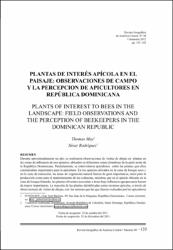| License | Creative Commons License Attribution-NonCommercial-ShareAlike 4.0 International, CC BY-NC-SA 4.0 International. | es |
| Author | May, Thomas | |
| Author | Rodríguez, Sésar | |
| Accessioned date | 2023-06-06T00:58:56Z | |
| Available date | 2023-06-06T00:58:56Z | |
| Year | 2012 | |
| Citation | May, T. y Rodríguez, S. (2012). Plantas de interés apícola en el paisaje: observaciones de campo y la percepción de apicultores en República Dominicana. Revista Geográfica de América Central, 1(48), 133-162. Recuperado de: | es |
| URI | https://bvearmb.do/handle/123456789/2805 | |
| Abstract | [Español] Durante aproximadamente un año, se realizaron observaciones de visitas de abejas en plantas en las zonas de infuencia de tres apiarios, ubicados en diferentes zonas climáticas de la parte norte de la República Dominicana. Paralelamente, se entrevistaron apicultores sobre las plantas que ellos consideraban importantes para la apicultura. En los apiarios ubicados en la zona de bosque seco y en la zona de transición, las áreas de vegetación natural fueron de gran importancia, tanto para la producción como para el mantenimiento de las colmenas, mientras que en el apiario ubicado en la zona de bosque húmedo, las plantas silvestres asociadas a áreas bajo infuencia agropecuaria fueron de mayor importancia. La mayoría de las plantas identifcadas como recursos apícolas, a través de observaciones de visitas de abejas, son las mismas que las que fueron evaluadas por los apicultores como importantes para la apicultura, aunque los apicultores tienden a sobrevalorar las plantas de áreas culturales, y de subvalorar las plantas de áreas silvestres, de acceso relativamente difícil. | es |
| Abstract | [English] For approximately one year, observations were made of visits of honeybees at plants in the area of influence of three apiaries situated in different climatic zones of the northern region of the Dominican Republic. At the same time, the beekeepers were interviewed about plants they considered important for beekeeping. In the apiary of the dry forest zone and of the transitional zone, the areas of natural vegetation were of great importance, for production as well as for the maintenance of the hives, whereas in the apiary of the humid forest zone wild plant species in areas under influence of agriculture and animal husbandry were most important. Most of the plant species which were identified as resources for honeybees were mentioned by the beekeepers as important for beekeeping, but there is a tendency that they overrate plants of areas under cultural influence, and underrate plants from natural areas of relatively difficult access. | es |
| Language | Spanish | es |
| Published | Revista Geográfica de América Central, 1(48), 133-162 | es |
| Rights | © Los autores. | es |
| Rights URI | https://creativecommons.org/licenses/by-nc-sa/4.0/deed.es | es |
| Subject | Flora ─ República Dominicana | es |
| Subject | Botánica | es |
| Subject | Hábitats y especies | es |
| Subject | Biodiversidad - República Dominicana | es |
| Title | Plantas de interés apícola en el paisaje : observaciones de campo y la percepción de apicultores en República Dominicana | es |
| dc.title.alternative | Plants of interest to bees in the landscape : field observations and the perception of beekeepers in the Dominican Republic | es |
| Material type | Article | es |
| Type of content | Scientific research | es |
| Access | Open | es |
| Audience | Technicians, professionals and scientists | es |


